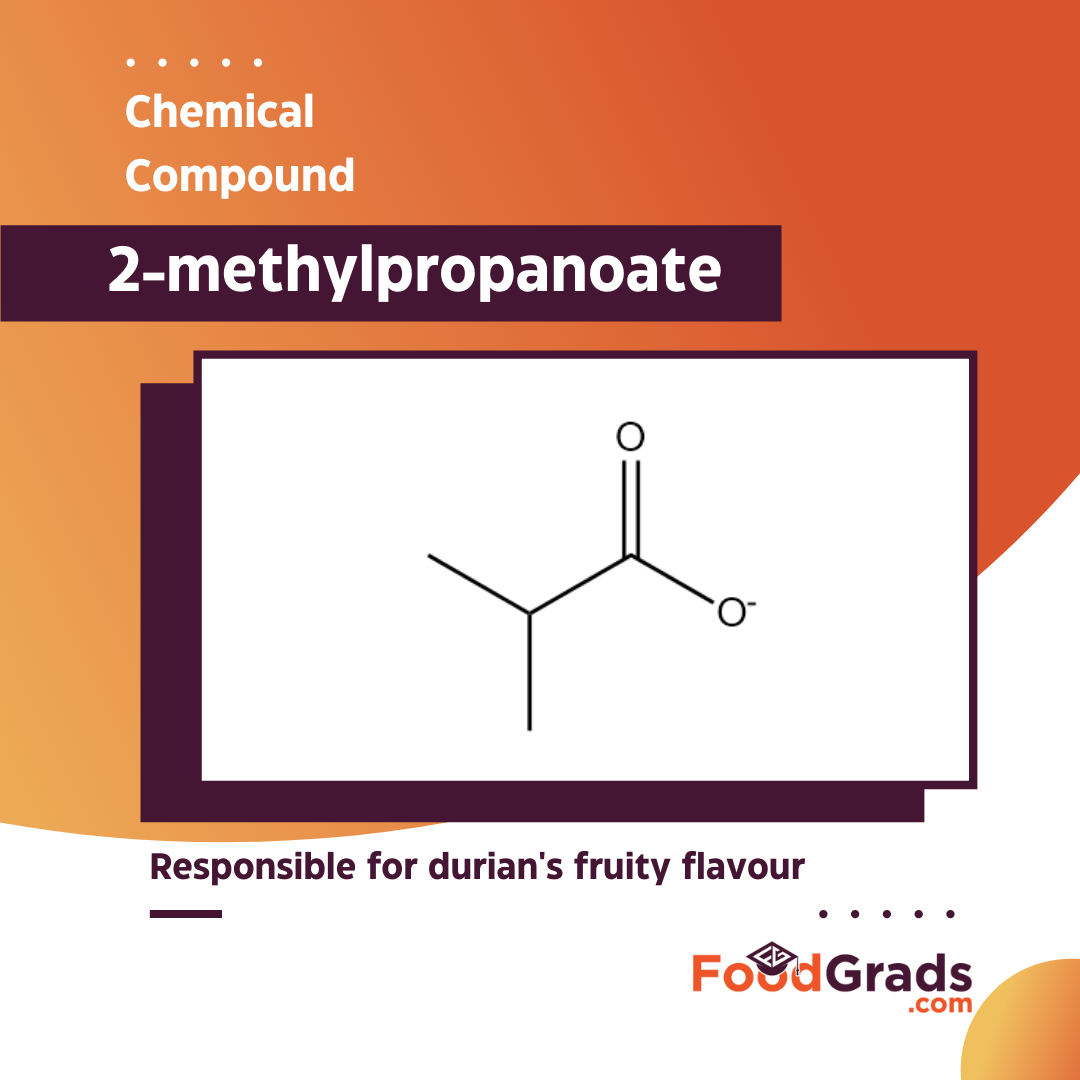Uncovering the Chemistry Behind Durian’s Polarizing Aroma
Last Updated on July 28, 2024
Dubbed the King of Fruits, durian is an exotic fruit found in Southeast Asia where the pungent aroma is even forbidden in some public places. Durian is famously used in desserts such as ice cream, cakes and pastries. It is also quite expensive at $16-20 per kilogram. The fruit is thorny, green-coloured and grows on trees, split from different capsules called carpels. Additionally, durian grows off trees through a stem or stalk called a peduncle. Then, inside the fruit, it contains a creme-coloured and edible pulp called aril. Lastly, a thick husk covered with thorns protects the fruit.
How Does the Durian Smell Develop?
During ripening, durian emits ethanethiol and ethanethiol derivatives that give off a strong smell. A specific enzyme causes the breakdown of the amino acid ethionine. Some studies have hypothesized that the enzyme methionine-lyase (MGL) causes the breakdown of methionine (an antimetabolite of ethionine). As a result, it forms methanethiol and derivatives producing a pungent fragrance mimicking scent of organosulfur odorants. Some organosulfur odorants in durian include:
- 1-(ethylsulfanyl)ethane-1-thiol
- 1-(ethylsulfanyl)propane-1-thiol
- diethyl trisulfide
- 1-(ethyldisulfanyl)
- (ethylsulfanyl)ethane

Additionally, methionine acts as an intermediate in the enzymatic breakdown of ethionine and smells like hydrogen sulphide. Since many alcohols are produced during this process, this defines the foul-smelling scents beyond the scents of typical fruits. Some examples of alcohols and their scents would be:
- methanethiol (rotten, cabbage)
- ethanethiol (rotten, onion)
- propane-1-thiol (rotten, durian)
- and the methionine smells like hydrogen sulphide (rotten egg)
Durian and Toxicity in Animals
Some studies suggest that durian may be toxic to animals. Ethionine is an antagonist of methionine and prevents the activation of methionine in animals. Additionally, these studies suggest that ethionine is a carcinogenic compound and tumorigenic, as it imitates the function of methionine and becomes an antagonist by binding to methionine adenosyl transferase. As a result, this creates issues in the epigenetic processing of animals by stopping the methylation of amino acids. Although it is known to be a toxic compound in animals, toxicity effects in humans have yet to be researched.
Do All People Dislike the Smell of Durian?
Despite durian being a banned fruit in some places and having a strong “stinky” smell to some people, durian is still considered a delicacy. Durian has many esters and ethyl groups that also create a pleasant fruity smell. Research has found there are specific chemicals that produce the pleasurable scents and flavours associated in durian. Examples include (2S)-2methylbutanoate which mimics the smell of honey, 2(5)-ethyl-4-hydroxy-5(2)-methylfuran3(2H)-one which gives a caramel taste, and ethyl 2-methylpropanoate and ethyl butanoate which produce fruit flavours.

Human’s taste buds and olfactory bulbs help to interpret the durian’s flavour including the five tastes of umami, sour, sweet, bitter and salty. Taste buds are sensory cells that can detect the tastants in food and send neural responses to our brains to distinguish and recognize the flavours in food. Each person has 5000 –10000 taste buds that stimulate sensory cells to deliver signals to nerve fibre ends, thereby heading to the thalamus to be relayed to the cerebral cortex. The cerebral cortex contains the gustatory cortex which perceives aromas and flavours. Other than taste receptors, a human’s olfactory bulb houses olfactory receptors which detect odours and variability in human olfactory bulbs explain why some people may interpret scents as stinky vs aromatic.
Nutritional Content
Other than just taste, durian may be consumed thanks to its nutritional content. Durian is known to be nutritious due to its high content of minerals of thiamine, magnesium and potassium. Aside from minerals, it contains vitamin C and vitamin B6. In addition, it is rich in antioxidants of flavonoids, carotenoids and polyphenols. Not to mention, some studies suggest that it may decrease blood sugar levels and decrease cholesterol levels.
Conclusion
Overall, durian is a divisive fruit due to its distinctive fragrance. Although it does have an odour which resembles putrid scents such as smelly onions or rotten eggs it is still considered a delicious delicacy. On the other hand it emits fragrant smells due to aldehyde and esters that produce smells found in traditional desserts and other fruits. Above all, the perception of durian’s taste and smell lies in taste buds and olfactory receptors. As some may choose to consume durian for its nutritional value.

About the Author: Hi! I am Bertina Do, a first-year food science student attending the University of Guelph. I have a fascination with food chemistry and molecular gastronomy.


leave your comment